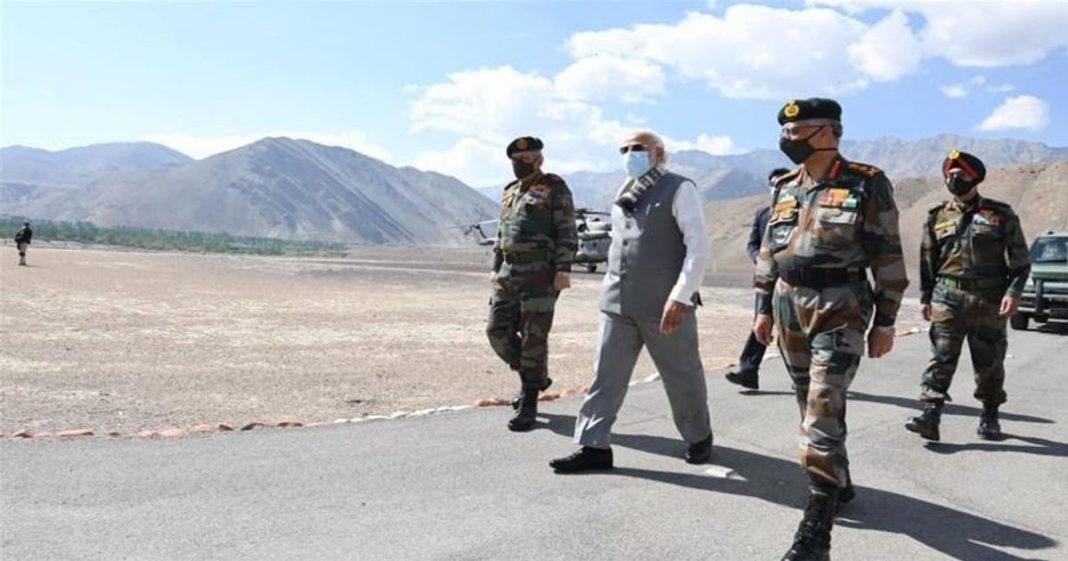Prime Minister Narendra Modi made a surprise visit to India’s northern frontier region with China on Friday in his first trip to the area since a deadly border clash last month.
The incident in the Galwan Valley saw 20 Indian troops killed and was the first time in 45 years that soldiers had died in combat on the Asian giants’ long-disputed Himalayan border.
Modi pays a visit to Ladakh border amid rising tensions
Modi toured a military base at Nimoo in Ladakh, about 100 kilometres (60 miles) as the crow flies from the site of the June 15 battle.
He was due to go to a military hospital in nearby Leh to meet soldiers injured in the hand-to-hand skirmish, a security source told AFP. The head of India’s military and the army chief also joined the visit to the sensitive area, which has been used as a staging post to build up troop numbers in the region.
Indian Prime Minister Narendra Modi on Friday paid a surprise visit to the Ladakh region. His trip comes weeks after Indian and Chinese troops clashed on the disputed border area. pic.twitter.com/cmZEOHKzgD
— Frontline (@Frontlinestory) July 3, 2020
Modi, who has been under pressure to respond to what India deems Chinese incursions, met troops at a base in Ladakh’s Nimu area, pictures showed.
Modi, on his visit to Ladakh border, was accompanied by the chief of defence staff, General Bipin Rawat, and the chief of the army, General Manoj Mukund Naravane.
Analysts say the current standoff at the Line of Actual Control (LAC) is a result of Chinese pushback against India’s building of military infrastructure at the de facto border in recent years.
Ongoing clashes between troops at Ladakh border
The recent clashes between China and India are a manifestation of long-standing tensions between the two nuclear-armed neighbors, according to an expert on South Asian geopolitics.
“The Himalayan border problem between Pakistan, India, and China is not a new issue – it goes back at least 70 years,” Umit Alperen, a researcher and professor, said in an online discussion with Cemal Demir, head of the Istanbul-based South Asia Strategic Research Center (GASAM).
Read more: India China tensions over Ladakh could explode at any time
China also suffered casualties but has not given details. Both sides have blamed each other for the incident and since sent thousands of extra troops to the region.
China and India’s military clash can be seen as the surfacing of a tension that has been there for some time, and an escalation accelerated by domestic, regional, and global factors, he said.
They have held several rounds of military-level talks and said they want a negotiated settlement but have made little apparent progress. India has also attempted to turn the screws on China economically, this week banning 59 Chinese mobile phone apps including the popular TikTok citing national security concerns.
With anti-China sentiment on the rise locally, Chinese imports including raw materials vital to India’s pharmaceutical industry have reportedly been piling up at Indian ports due to more stringent border checks.
India trying to get chummy with Russia by ordering fighter jets
Meanwhile, India’s defence ministry Thursday signed off on the purchase of 33 Russian fighter jets and upgrades to 59 others worth $2.4 billion, amid rising tensions with nuclear-armed neighbour China. India buys Russian jets in the wake of the humiliation at Ladakh, which has accelerated its plans to modernize its military.
Read more: India buys Russian jets worth $2.43 bn: an attempt to curry favour with Putin?
The purchase of 21 MiG-29 and 12 SU-30 MKI, as well as upgrades to 59 existing MiG-29s, was to “augment” the Indian Air Force’s combat squadrons, the ministry of defence said.
The beefing up of New Delhi’s defence capabilities was taken due to “the need to strengthen the armed forces to protect our borders and Prime Minister Narendra Modi’s call for ‘Self-reliant India’”, the ministry added in a statement.
India announced that it is buying $2.4b worth of Russian jets in the wake of the Ladakh disaster. It seems that India wants to bring Russia on to its side, but the path is not as simple as it seems. https://t.co/gRD4tl7sMQ
— GVS (@GVS_News) July 3, 2020
The announcement followed Modi’s phone call with his Russian counterpart Vladimir Putin, where he “warmly congratulated” the president after a nationwide vote on constitutional reforms that could allow him to extend his rule until 2026.
Speaking to GlobalVillageSpace, Andrew Korybko gives his insights into how Russia is positioning itself in the conflict between China and India. As reports of the situation in Ladakh finally cooling emerge after the meeting between the foreign ministers of Russia, India and China, the role of Russia has been significantly questioned. He says that India can not expect Russian help because of a strategic shift in relations, and also makes predictions for the future of Russian diplomacy and the situation in South Asia.
Modi’s visit to Ladakh border seems to be an indication that tensions are high, and the Indian Prime Minister wanted to ensure that his country was ready for war if it comes to that.
GVS News Desk with additional input by AFP and other sources
Is Modi trying to garner Russian support? What are your views on this? Share with us in the comments bar below.














